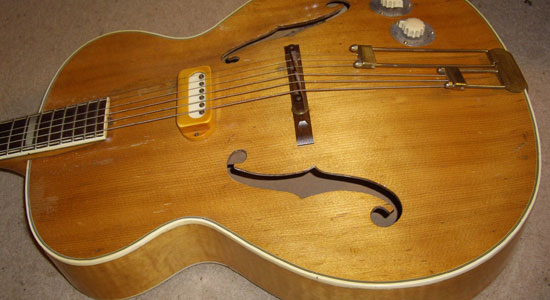 Even if he wanted to, Giant Sand’s Howe Gelb couldn’t repeat himself. Just watch him sing sometime; the guy’s got two vocal mics, one distorted, one clean, and he doesn’t make up his mind which one he’ll be singing into until he’s halfway through his line. Tucson (Fire), Gelb’s latest release (credited to Giant Giant Sand), is named after his Arizona hometown. He will also be guest editing magnetmagazine.com all week.
Even if he wanted to, Giant Sand’s Howe Gelb couldn’t repeat himself. Just watch him sing sometime; the guy’s got two vocal mics, one distorted, one clean, and he doesn’t make up his mind which one he’ll be singing into until he’s halfway through his line. Tucson (Fire), Gelb’s latest release (credited to Giant Giant Sand), is named after his Arizona hometown. He will also be guest editing magnetmagazine.com all week.

Gelb: First, take the shape of the neck and how it fits inside your fist. The thumb tends to wrap around the neck then, the way instructors say it shouldn’t, immediately rebellious then meeting the fingers half way on the fret.
If it fits well, you know it instantly. If it takes some “getting used to,” you’ll know that has its worth, too. Some new chord will form for you out of the discomfort.
The other arm now lunges over the body like an embrace. Fingers sprawl on the sproing of strings that spring them like a trampoline. The wood of it all, that element that never releases what it soaks up except in the possible haunt of tone that has been measured by the sweat poured in while the sound waves pounded into it endlessly like a sonic sea. Sometimes blood finds its way into the grain; a violent flashing rhythm one night that splatters the player’s juice across its landscape and into the wood forever.
Then the salt of a man’s tears over a women or just the opposite. Some combination of any human over another and the sheer absence of that person, especially when that one was needed most, becomes part of the wood. That guitar soaked it all up; now it’s all in your hands, what are you gonna do with it? What’s it gonna to with you? The thing has been around for a long time, long enough for it to hold 100,000 songs and the many stories that surround them; a piece of swollen wood collecting human taint for generations. The thing is an antennae; it has the alchemy to pick up signals if the right conductor of such reception picks up on that kind of plucky transmission.
But stop for a moment; don’t imagine the players through the decades that have held her tight on many a sweaty night or sun-soaked afternoon drip. Think about its maker. In the beginning, the one who first knew the wood to be good, who carved the tone upon her and who first breathed life into the thing before sending it on its way. They send if off as if it were something that could change history or change the way we hear things, if only a beat at a time. There in the arms of a sonic soldier instead of a rifle, giving life instead of taking it and allowing a dance instead of silencing shot.
When I picked up one such thing last summer, I was already sworn off ever buying another guitar; I had plenty, too many, really. But it found me, there in a place where I shouldn’t have normally been, trying not to recognize how wonderful it impossibly seemed. To hold it and made dizzy by the murmur mentioning its only veer had one owner, and it’s a 1947 Epiphone.
Formed in the gleeful years just after the war to end all wars, clutched by a man who shoved his whole life into song by song, and the kicker was the belt-buckle rash in the back of it: it was heart shaped. It was the kind of tender trap that if one made the responsible decision by not buying another guitar, it would have surely haunted him the rest of his days. After starring at the heart on the back for so long, lost in the impossibility of that shape having formed there, I slowly noticed something else barely scratched in there too on each side of the heart. A lighter scratching, but now very obvious nonetheless: two long lines of scratchings that could only have been made by a wheelchair in a man’s final years.






